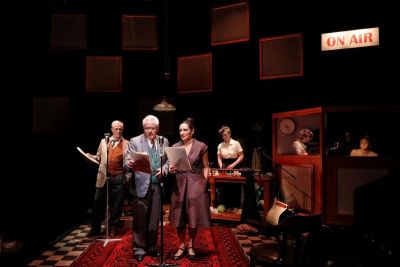Murder on the Wireless
This is a strange one. The first night audience assembled, ready to laugh or gasp at a new play by Mark Kilmurry, Artistic Director of the Ensemble. He welcomes them, explains in character that this is London in 1959, that we are to see two radio plays performed in real time. He introduces his fellow actors (Georgie Parker and Daniel Mitchell) and the Foley Artist (Katie Fitchett) who will provide all necessary background sounds, from door-bangs to footsteps in the gravel. Audience primed, ready for fun, so off we go!
The first play is an adaptation of The Solitary Cyclist, a Sherlock Holmes story by Arthur Conan Doyle, hence the credit. Kilmurry plays Sherlock, Mitchell is the ever-puzzled Watson, and Parker is Violet Smith who reports that someone is chasing her on a solitary bicycle. It goes on a bit, as these things do, but the Foley Artist gets plenty of action and it’s fun watching her beat a rolled-up carpet or slam a door when required. The audience enjoy her dry antics, and the cyclist’s identity is perceived by the master in his usual ‘but-how-did-you-work-that-out-Holmes?’ manner.
 During the break, Kilmurry addresses the audience, gets us to clap and laugh loudly and softly, and we gladly oblige: perhaps we’ll be needed! Then it’s back to radioland and a live performance of The Dead(ly) Wives Club, in which a young couple do battle with a criminal mastermind, as they speed through the countryside (and etc). The Foley Artist does her stuff, the actors read their lines well, but the audience is quieter and more passive. There’s a moment when Daniel Mitchell, resting on a chair, misses his cue and it looks like the evening might turn into a ‘play that goes wrong’. But, no, the second play ends and so does the show.
During the break, Kilmurry addresses the audience, gets us to clap and laugh loudly and softly, and we gladly oblige: perhaps we’ll be needed! Then it’s back to radioland and a live performance of The Dead(ly) Wives Club, in which a young couple do battle with a criminal mastermind, as they speed through the countryside (and etc). The Foley Artist does her stuff, the actors read their lines well, but the audience is quieter and more passive. There’s a moment when Daniel Mitchell, resting on a chair, misses his cue and it looks like the evening might turn into a ‘play that goes wrong’. But, no, the second play ends and so does the show.
There’s nothing wrong with the actors or the setting, and sometimes - in the first play at least – the idea behind the evening is intriguing. What is required is purpose. The audience knows it. Something extra needs to happen, and it doesn’t.
Just a thought: the term ‘Foley Artist’ applies only to sound effects providers on film. I’ve never heard it connected with radio drama before, certainly not with the BBC in 1959.
Frank Hatherley
Photographer: Prudence Upton
Subscribe to our E-Newsletter, buy our latest print edition or find a Performing Arts book at Book Nook.

